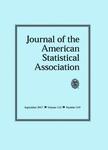-
作者:Efromovich, S
作者单位:University of New Mexico
摘要:This article addresses the problem of finding a relationship between the univariate predictor and the response when regression errors, created in part by known auxiliary covariates, are too large for a reliable regression estimation. A typical example is a controlled random design experiment with a large number of covariates, where the statistician is interested in the effect of a particular covariate and this effect is blurred by a large regression noise created by other covariates. This arti...
-
作者:Fan, JQ; Peng, H; Huang, T; Ren, Y
作者单位:Princeton University; Yale University; University of Hong Kong
-
作者:Gelfand, AE; Kottas, A; MacEachern, SN
作者单位:Duke University; University of California System; University of California Santa Cruz; University System of Ohio; Ohio State University
摘要:Customary modeling for continuous point-referenced data assumes a Gaussian process that is often taken to be stationary. When such models are fitted within a Bayesian framework, the unknown parameters of the process are assumed to be random. so a random Gaussian process results. Here we propose a novel spatial Dirichlet process mixture model to produce a random spatial process that is neither Gaussian nor stationary. We first develop a spatial Dirichlet process model for spatial data and discu...
-
作者:Serban, N; Wasserman, L
作者单位:Carnegie Mellon University
摘要:CATS-clustering after transformation and smoothing-is a technique for nonparametrically estimating and clustering a large number of curves. Our motivating example is a genetic microarray experiment, but the method is very general. The method includes transformation and smoothing multiple curves, multiple nonparametric testing for screening out flat curves, clustering curves with similar shape, and nonparametrically inferring the clustering estimation error rate.
-
作者:Kim, HM; Mallick, BK; Holmes, CC
作者单位:Konkuk University; Texas A&M University System; Texas A&M University College Station; University of Oxford
摘要:In many problems in geostatistics the response variable of interest is strongly related to the underlying geology of the spatial location. In these situations there is often little correlation in the responses found in different rock strata, so the underlying covariance structure shows sharp changes at the boundaries of the rock types. Conventional stationary and nonstationary spatial methods are inappropriate, because they typically assume that the covariance between points is a smooth functi...
